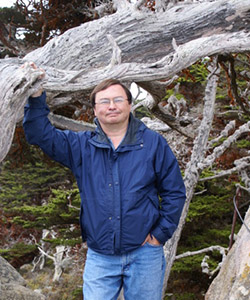EOAS Member Directory

Peter Morin
Community ecology; herpetology; aquatic entomology
Cook Campus
School of Environmental and Biological Sciences
Dept of Ecology, Evolution, and Natural Resources (DEENR)
Dr. Morin has 4 core areas of research interest:
- Biodiversity and Ecosystem Functioning
Much of our recent research has focused on relationships between biodiversity and ecosystem functioning in natural and model communities. Dr. Morin’s laboratory uses microcosms containing microbes to test basic ideas about the role of different species in driving community and ecosystem processes. These studies include explorations of links between diversity and ecosystem predictability, and studies of effects of biodiversity on responses of ecosystems to gradual environmental change. Other studies have used assemblages of amphibians to directly examine the extent of functional equivalence in temporary pond communities. - Ecological Networks
Past research in his group has explored the consequences of food web structure for the population dynamics of component species, relations between productivity and food chain length, and effects of different top predators on food web composition. Current research is exploring the impacts of non-native species on the structure and functioning of terrestrial food webs. - Inducible Trophic Polymorphisms
New work in Peter’s group is examining the role of inducible trophic polymorphisms and intraguild predation in generating alternate community states. Related work is examining the population dynamics of protist species with inducible trophic polymorphisms, to understand how environmental variation is related to their expression, and to experimentally demonstrate the adaptive significance of these spectacular examples of phenotypic plasticity. - Community Ecology
He is generally interested in the roles of interspecific interactions and abiotic factors in producing patterns of species diversity and community composition. Peter’s textbook Community Ecology 2e summarizes current views about the factors that structure communities. Topics of particular interest include the interactive effects of competition, predation, and the history of community assembly on patterns of species abundance in organisms including protists, insects, and amphibians. Other work is exploring the process of community assembly and the potential consequences of irreversible community changes for ecological restoration efforts.


